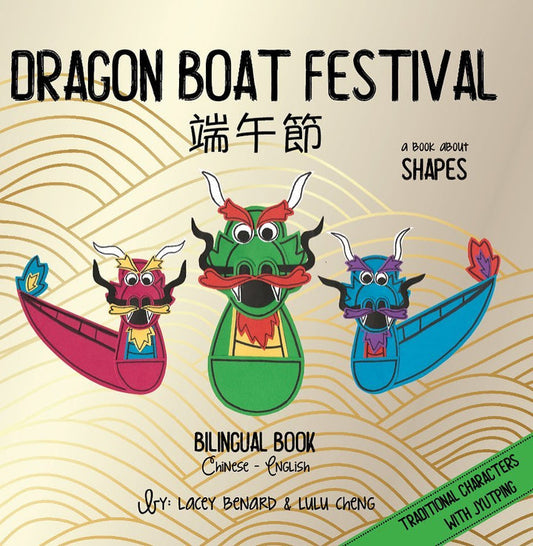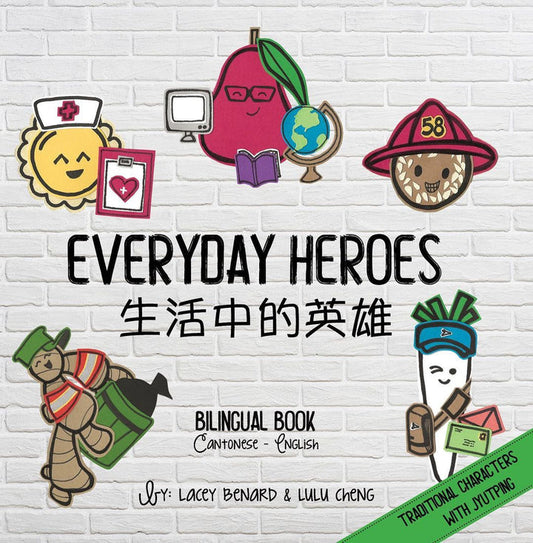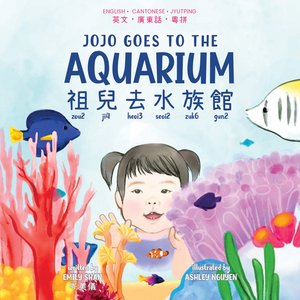Our Parent Spotlight this month will feature Lauren!
Lauren is a 4th generation Canadian raising a little boy in Cantonese and Korean. She researches extensively for resources with Cantonese and jyutping so she can read with her son. She has a great list of books to share with families - take a look!
Meet Lauren!

Hi Lauren! Can you tell us a bit about you and your family?
Hi! My name is Lauren, and I’m a 4th generation Canadian. I feel fortunate to have such a big family here with me in Canada, and almost all of my relatives, including my grandparents and great-aunts and uncles, speak English.
When I was in elementary school, I thought being a 4th generation Canadian was normal, as there were four of us in my class. I’m pretty sure my parents offered Chinese school to me when I was little, however I declined in favour of other extracurriculars.
When I went to high school and university, I was surprised to learn that my family was a minority in the Chinese community. We spoke only English at home, and I knew very little Chinese.
My mom’s side speaks Toisan and my dad’s side speaks Jung Sing. When they were growing up, they were frequently the only Chinese child in their class, and I gather it was much more challenging to be Chinese in the generations before mine.

When my toddler O. was born, I decided that I wanted him to be more connected to our culture. My husband is fluent in Korean, and the common language in our household is English. It has been a humbling experience trying to learn Cantonese and understand more about our culture. Our family is all learning together.
I am still very much a beginner in conversational Cantonese, and I hope that I am picking up some Chinese characters along the way.
What motivated you to start teaching Cantonese at home?
O. has been my motivation to both learn and teach Chinese. O. was just over 1 years old when I bought the Bitty Bao Cantonese bundle. At the time they only had three books with jyutping. I was so excited to discover these bilingual board books and jyutping! I could read to my baby in Cantonese without being able to read the Chinese characters, the illustrations were so cute and O. could hold them as they were quite sturdy.
What other resources did you use?

While searching for purchasing options, I discovered Yuto.ca, and there I saw that she had a free weekly Cantonese reading group online! This was so convenient and perfect!
O. loved the songs that Eveline sang along with the stories, and when I asked her about where to find the songs, she told me about her Rhythm ‘N’ Rhyme Roundabout Cantonese Music class with Locy Lee. The classes even came with bilingual lyrics with jyutping, so even as a beginner I could learn the songs and sing them with O. O. and I have been attending Roundabout ever since, and O. frequently breaks into songs that we have learned at these lovely online music classes.
Was it easy to learn and teach at the same time?
At the beginning, trying to learn and teach at the same time was both exciting and exhausting as my brain tried to awaken and strengthen the pathways from when I was a toddler being cared for by my grandparents.
Now I can see improvements in my vocabulary and comprehension, although I am still very much a beginner.
It has been exciting to share some of what we have learned about our culture and language to my cousins and siblings who were also brought up in English-speaking households.

What are your main goals for teaching Cantonese?
My goal was for O. to feel connected to his Chinese culture and be able to order dim sum and have conversations in Cantonese. I try to introduce everyday vocabulary, and Little Canto Learning’s books have been very engaging for O. with the real images. Food, feelings and culture are my top three picks.
Cantonese4Parents has started a podcast that has jyutping and English subtitles on Youtube which has been great for emotions and mindfulness tools! SweetNote Learning and EdKids Home have been great resources for printables for the holidays. As our family is only a few years into our learning journey, our goals have not yet changed.
What plans do you have in teaching Cantonese and Korean?
Our method of teaching both Cantonese and Korean is: any exposure is good. We hope to create pathways in O.’s brain that he can return to and build on later.
This helps us feel less pressured and allows us to speak in Chinese or Korean when we have the energy, and to still communicate to each other comfortably in English at other times.
We feel this method is working as he sings Rhythm ‘N’ Rhyme songs, remembers vocabulary and even started calling out “Chinese!” whenever he saw Chinese characters when he started being able to talk.
What resources would you recommend to other families?

Through Eveline’s Cantonese Parents in BC Facebook group, I have discovered a whole community of parents passing Cantonese on to their children, and so many more resources to help us on our journey. I am so grateful to all the creators and parents who have been so accepting and supportive of our endeavours to reconnect to our culture. I highly recommend joining online and in-person communities!
- Bitty Bao and Rhythm ‘N’ Rhyme have been such a blessing and instrumental to helping us connect with Chinese culture.
- The Cantonese storytimes that Eveline and Yuto Books have done all over our community as part of cultural festivals have been so amazing to help give O. some hands on experience of Chinese culture.
- As I mentioned earlier, Cantonese4Parents has started a podcast that has jyutping and English subtitles on Youtube which has been great for emotions and mindfulness tools!
- Sweet Note Learning and EdKids Home have been great resources for printables for the holidays.
- CultureTaterTots gave us the idea to make playdough mooncakes with my family, and on their resources page I found a link to the Cantonese Tones video from Cantonese Corner which is helping me read jyutping and speak better.
- LocyLee Learning has wonderful songs on her Youtube channel, and O. loves gung1 gai1!
- Twinklebots Cantonese Youtube channel has great vocabulary videos and some songs too. O. has watched the Planes, Trains and Automobiles video with real vehicle footage many, many times.
- Cantonese for Families has also provided great collections of videos, printables and crafts.
- RedEgg.ca also has some cute free colouring pages and ebooks.
I was so amazed to find so many Cantonese resources available! I’m probably missing some.
What books do you recommend for the little ones?

- I recommend Bitty Bao books for the wee little ones as they are simple, cute and durable.
- Jojo books also look great for toddlers!
- Little Canto Learning’s My First Words as a table book (I use a recipe holder to prop it up and O. likes to point at pictures for me to read the Cantonese word), and also all of Farina Leong’s other books! I especially appreciate her Daily Vocabulary books to help us learn conversational everyday Cantonese.
- O. loves “I Found It!” from LycheePress by Katrina Liu.
- and we are looking forward to more Calvin books from Green Cows Books by Karen Yee.
What are your main goals for teaching Cantonese?
My original goals were for my kids to understand and speak in Cantonese. Now, goals are for them to understand, speak, read a few words, and have fun in Cantonese.
Did you have any struggles or challenges when you first started teaching?
The biggest challenge with raising multilingual kids is the time and energy it takes to continue to make sure the languages and cultures are present on a regular basis. Having a weekly online class like Roundabout Cantonese Music and Little Readers Club has been extremely helpful, as is having Chinese books available for O. to pick up on his own and read or ask for us to read with him. Hearing O. speak Cantonese and Korean (in that adorable little voice!), seeing his interest in his many cultures, and learning and remembering my culture has been very motivating for me.
Do you have any rewarding moments to share?
I am so proud of O. for having learned so many songs in Cantonese and remembering so many words already! We have been surprised many times when he knows words in Cantonese that we haven’t used in quite some time! As I mentioned earlier, it has been exciting to share some of what we have learned about our culture and language to my cousins and siblings who were also brought up in English-speaking households.
Even more rewarding is that O. has retained a lot of vocabulary, and frequently helps me remember how to say things in Cantonese!
It has been heart-warming to watch my Po4 Po2 read to O., and watching her smile when we put up fai1 ceon1 in her house for Lunar New Year made me so happy.
Do you have any advice for parents who are undecided about starting Chinese at home?
My advice would be to start sharing Chinese in whatever way you feel comfortable. No pressure, just whatever feels fun, exciting and doable. Books and songs seem to be a great way to introduce another language.
Did you have an interesting experience you’d like to share from your Chinese journey?
Sometimes when we don’t understand O. in English, he says the word again in Cantonese or Korean and then we get what he is trying to say!
What are your favourite books to read together with your child?

Bitty Bao Counting with Dim Sum - teaches counting and dim sum vocab! Nice, simple read, very cute photos. Has audio by Eveline! Bitty Bao Emotions - teaches Cantonese and emotional awareness at the same time! I love the emotions chart at the back. O. loves to point at the different bubble tea and ask why they are feeling that emotion. Also has audio by Eveline!
My First Words in Chinese by Farina Leong. Also has audio! I Found It! By Katrina Liu - bright and engaging illustrations that O. likes to point at, vocabulary with jyutping at the bottom and audio!
Any final thoughts to share with the community?
I really appreciate everyone’s patience, support and guidance when I don’t understand what’s being said, or need jyutping or English translation. I know I’m in the minority as I am a beginner myself, and I have felt myself and O. have been so accepted and included by the Yuto founders and the Cantonese community. Thank you for everything!
Thank you, Lauren, for sharing your experiences with us in raising multilingual toddler. And thank you for the sharing such wonderful resources and doing all the research - we're sure families really appreciate having a place to start looking for their own little ones.







![Bitty Bao: Celebrating Chinese New Year • Cantonese [Reimagined]](http://yuto.ca/cdn/shop/files/9781958833780_cfl.jpg?v=1703919885&width=533)

![Bitty Bao: Counting with Dim Sum • Cantonese [Reimagined]](http://yuto.ca/cdn/shop/files/bb-dimsum-01_1080x_58fb9840-2da8-430c-a83f-927e5e5a078b.jpg?v=1732408528&width=533)
![Bitty Bao: Lucky Lunar Animals • Cantonese [Reimagined]](http://yuto.ca/cdn/shop/files/9781958833797_cfl.jpg?v=1703920872&width=533)
![Bitty Bao: Boba Emotions • Cantonese [Reimagined]](http://yuto.ca/cdn/shop/files/9781958833315_cfl_1080x_6eaa4f87-4924-41f9-bcd3-13b77a6140db.jpg?v=1732406457&width=533)

![Bitty Bao: Foodie Detectives • Cantonese [Reimagined]](http://yuto.ca/cdn/shop/files/9781958833445_cfl_1080x_a432d852-3fee-46c8-95ae-e1964ee84d3e.jpg?v=1732406050&width=533)
![Bitty Bao: The Colors of Snow Ice • Cantonese [Reimagined]](http://yuto.ca/cdn/shop/files/9781958833223_cfl_1080x_43c54c6e-a2d8-4f06-9b5c-8f7c87ee7c22.jpg?v=1732408787&width=533)
